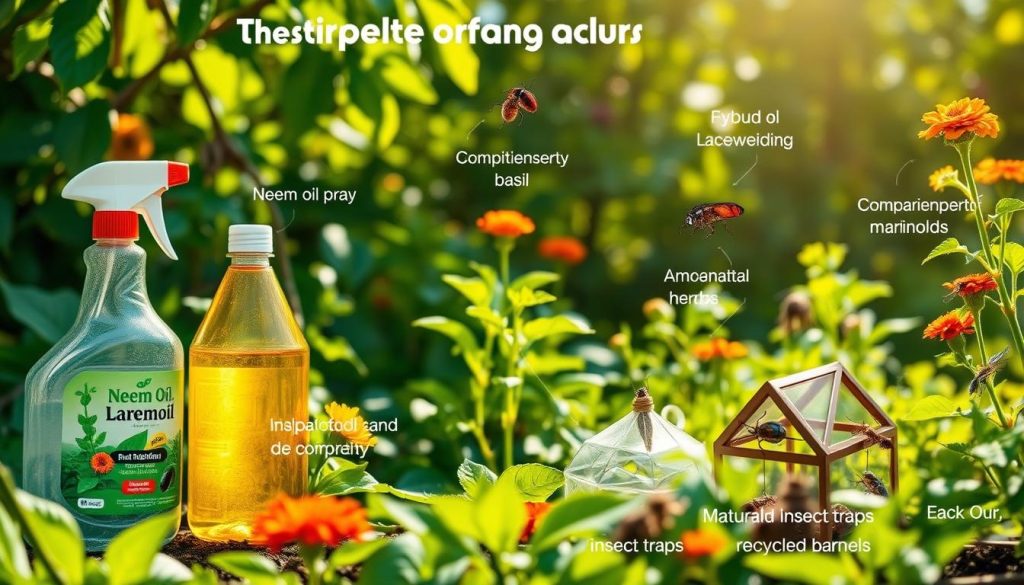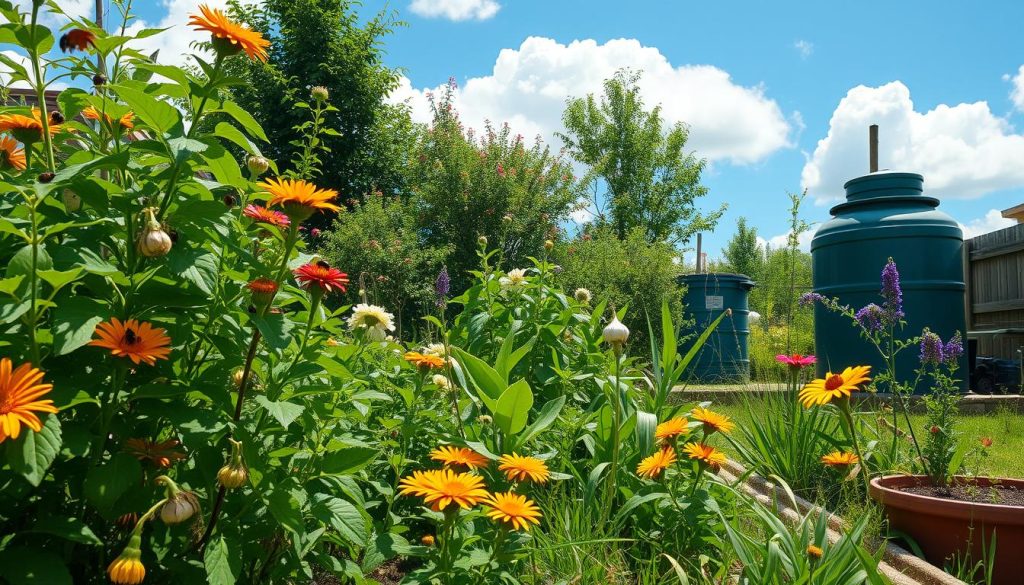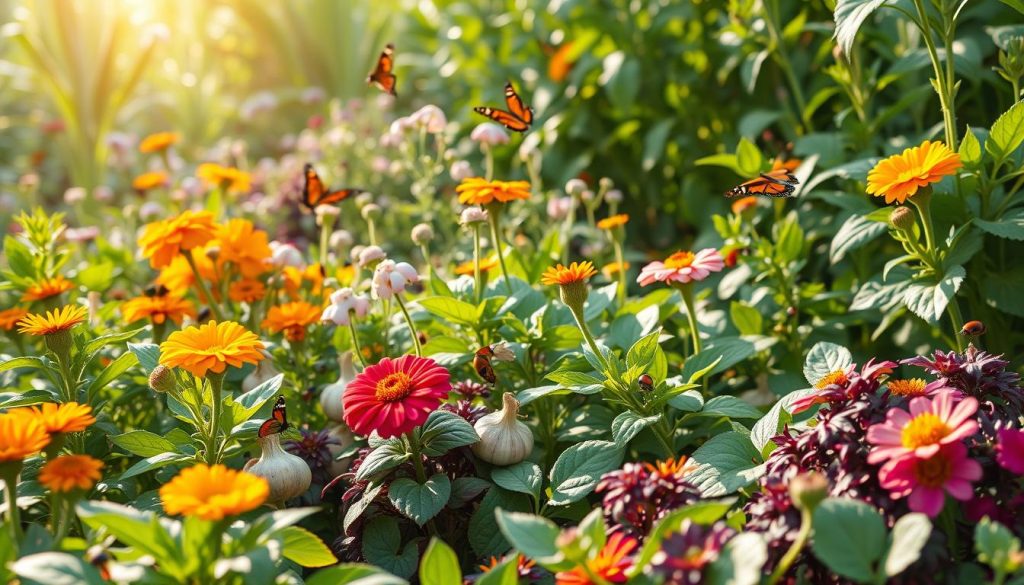I’ve discovered that natural pest control is the best way to keep critters out of my home. It doesn’t involve harsh chemicals. Instead, I use eco-friendly methods to keep my home safe for my family and the planet.
Switching to natural pest control has changed my life. It’s shown me that a holistic approach to pest management is essential. In this article, I’ll share my top methods for keeping pests away naturally.
I want to show readers why natural pest control is so important. I’ll give them the tools and knowledge to keep their homes pest-free. My hope is to encourage others to adopt a natural approach to pest control, making their homes healthier and more sustainable.
Understanding Natural Pest Control Methods
Natural pest control methods are a great way to fight pests without harsh chemicals. They aim to make your environment less welcoming to pests. This is perfect for those who want to use organic solutions. It also helps keep you and the planet safe from toxic chemicals.
What Are Natural Pest Control Methods?
Natural pest control includes several techniques, such as:
- Sealing entry points to prevent pests from entering the home
- Eliminating food sources to discourage pests from staying
- Using natural deterrents, like essential oils, to repel pests
These methods are not only effective but also healthier than traditional pest control.
Benefits of Using Natural Approaches
Using natural pest control has many benefits. Some of these advantages are:
- Reduced risk of exposure to toxic chemicals
- Protection of the environment
- Creation of a healthier home
Choosing organic pest control and non-toxic remedies makes your home safer and more sustainable.

Essential Tools for Natural Pest Control
To keep pests away naturally, you need the right tools. I’ve found that a good pest control kit is key. It should have diatomaceous earth, essential oils, and natural insecticides. These are all important for getting rid of pests without harming the environment.
Here are some must-haves for my pest control kit:
- Diatomaceous earth, a natural powder that dehydrates insects
- Essential oils, such as peppermint and lemongrass, which repel pests
- Natural insecticides, like neem oil, that target specific pests
I also make my own pest control recipes at home. I use things I already have, like baking soda and vinegar. These recipes are cheap, eco-friendly, and work well. By using these tools and methods, I keep my home pest-free without harming the planet.

Identifying Common Household Pests
To get rid of pests without chemicals, you need to know what pests you have. Look for signs like droppings, gnaw marks, or seeing the pests themselves. Acting fast helps stop pests from spreading and keeps your home safe.
Signs of Pest Infestation
Here are some common signs of pests:
- Droppings or urine stains
- Gnaw marks on furniture or walls
- Actual sightings of pests, such as rodents or insects
- Unpleasant odors or sounds
Most Common Pests Encountered
Cockroaches, ants, and rodents are common pests. You can control them without harming the environment. Use methods like sealing holes, removing food, and natural repellents. This way, you can keep your home pest-free without chemicals.

| Pest Type | Signs of Infestation | Control Methods |
|---|---|---|
| Cockroaches | Droppings, egg shells | Sealing entry points, removing food sources |
| Ants | Trails, nests | Removing food sources, using natural deterrents |
| Rodents | Gnaw marks, droppings | Sealing entry points, using traps |
Natural Deterrents for Garden Pests
Exploring holistic pest management, I’ve learned natural deterrents are key. They help keep my garden healthy. By using natural pest control, I’ve cut down on chemical pesticides. This makes my garden ecosystem more balanced.
Companion planting is a great way to keep pests away. It pairs plants that repel pests with those that pests harm. For instance, marigolds with tomatoes fight nematodes. Basil keeps aphids and other pests off vegetables.
Companion Planting Techniques I Use
- Planting marigolds with tomatoes to deter nematodes
- Pairing basil with vegetables to repel aphids and other pests
- Using nasturtiums to repel whiteflies and other pests

Homemade Sprays for Effective Protection
I also make homemade sprays to protect my plants. These sprays use natural ingredients like neem oil, soap, and garlic. They target specific pests effectively.
Attracting Beneficial Insects
Attracting beneficial insects is key to eco-friendly pest management. By making your garden welcoming, you invite these helpful insects to stay. They eat pests, reducing the need for harmful chemicals and keeping your garden balanced.
Which Insects Help Control Pests?
Some insects are natural enemies of garden pests. These include:
- Ladybugs, which eat aphids and whiteflies
- Lacewings, which munch on aphids, whiteflies, and spider mites
- Parasitic wasps, which prey on caterpillars and other insects
How I Attract Ladybugs and Lacewings
To draw these beneficial insects, I plant flowers like marigolds and dill. These flowers offer nectar and pollen. I also steer clear of pesticides, which can harm these insects. This way, I make my garden a safe haven for ladybugs and lacewings, helping control pests naturally.
| Beneficial Insect | Pest Controlled | Attraction Method |
|---|---|---|
| Ladybugs | Aphids, whiteflies | Planting marigolds and dill |
| Lacewings | Aphids, whiteflies, spider mites | Planting dill and fennel |
| Parasitic wasps | Caterpillars, other insects | Planting herbs like parsley and basil |
Essential Oils for Pest Management
I’ve been looking into non-toxic ways to manage pests, and essential oils are a big help. They’re a key part of keeping pests away without harming the planet.
My Favorite Oils for Repelling Insects
Peppermint, lemongrass, and lavender are my top picks for keeping pests at bay. You can use them in sprays, diffusers, or even on surfaces.
How I Use Essential Oils Effectively
I mix essential oils with water and spray them around my home or garden. I also use diffusers to spread the oils in the air. Here’s how to use essential oils to keep pests away:
- Always dilute essential oils with water before applying them to surfaces.
- Use a diffuser to release the oils into the air.
- Apply essential oils directly to surfaces, such as countertops or baseboards.
Using essential oils has helped me cut down on chemical pesticides. It’s a greener way to keep pests out.
| Essential Oil | Pest-Repelling Properties |
|---|---|
| Peppermint | Repels ants, spiders, and mosquitoes |
| Lemongrass | Repels fleas, ticks, and flies |
| Lavender | Repels moths, flies, and mosquitoes |
Creating a Pest-Resistant Environment
To keep your home pest-free, it’s key to create a pest-resistant space. This means keeping your living area clean and using outdoor methods to ward off pests.
Tips for Maintaining a Clean Living Space
Keeping your home clean and free of clutter is vital. Here are some helpful tips:
- Regularly vacuum and dust all areas of the home
- Store food in sealed containers and clean up crumbs and spills immediately
- Take out the trash regularly and keep it in sealed bins
Outdoor Practices to Keep Pests Away
Sealing entry points and using natural deterrents can help keep pests away from your home. Some outdoor practices include:
By following these tips, you can create a pest-resistant environment. This will help keep your home and garden pest-free.
| Outdoor Practice | Description |
|---|---|
| Seal entry points | Seal all cracks and crevices around doors, windows, and pipes to prevent pests from entering your home |
| Use natural deterrents | Use natural deterrents such as citronella, lemongrass, or mint to keep pests away from your garden and home |
Natural Traps and Baits
I’ve found natural traps and baits to be great for pest control without harsh chemicals. Using common items, I make simple traps that catch pests well. They’re easy to make and work great.
Simple Traps I’ve Made at Home
I’ve made traps like sticky tape, jar, and bottle traps. They catch flies and spiders easily. Natural baits like fruit or sugar help lure pests into these traps.
Natural Baits That Always Work for Me
Apple cider vinegar, yeast, and sugar attract fruit flies well. Peanut butter or honey lure ants and spiders. These baits are safe for the environment and work well.
Using these natural traps and baits keeps pests away without harsh chemicals. It’s better for the planet and safer for my family and pets.
| Trap Type | Natural Bait | Pest Targeted |
|---|---|---|
| Sticky Tape | Sugar | Flies |
| Jar Trap | Fruit | Flies, Spiders |
| Bottle Trap | Apple Cider Vinegar | Fruit Flies |
Seasonal Pest Control Tips
As the seasons change, so do the pest control challenges. It’s key to adjust your natural pest control methods with the season. I’ll share tips for spring and summer pests, and winter pest prevention.
Using eco-friendly pest management can help reduce pest infestations. It makes your home healthier for your family and pets. Effective methods include sealing entry points, removing food sources, and using natural deterrents.
Preparing for Spring and Summer Pests
When it gets warmer, pests like mosquitoes, ants, and rodents become more active. Here’s how I prepare:
- Seal all entry points, including cracks and crevices around windows and doors
- Eliminate standing water and food sources, such as pet food and bird seed
- Use natural deterrents, such as citronella candles and essential oils, to repel pests
Winter Pest Prevention Strategies
In winter, pests like rodents and cockroaches look for warm homes. To keep them out, I use these strategies:
- Use natural insulation, such as diatomaceous earth, to seal gaps and cracks
- Seal drafts and vents to prevent pests from entering
- Keep your home clean and clutter-free to reduce the risk of pest infestations
Understanding Your Ecosystem
To use organic pest control, you need to know your home and garden’s ecosystem. This means seeing the good insects, using natural ways to keep pests away, and making a welcoming space. By choosing non-toxic solutions, you help plants grow well and keep pests away.
A balanced ecosystem is key for good pest control. It lets good insects help control pests. Ways to keep the ecosystem balanced include:
- Planting a variety of flowers and herbs to attract good insects
- Using natural deterrents, like essential oils and homemade sprays
- Creating a space that welcomes good insects with shelter and food
Why Ecosystem Balance Matters
Ecosystem balance is crucial for a healthy, pest-free space. When it’s balanced, good insects can thrive, and pests are kept in check. This method is not only effective but also good for the environment, avoiding harmful chemicals and supporting biodiversity.
How I Observe Natural Pest Control in Action
Watching natural pest control can be both interesting and educational. By noticing how good insects and pests interact, you learn more about your ecosystem. Some ways to observe include:
- Watching beneficial insects, like ladybugs and lacewings, eat pests
- Seeing how natural deterrents, like essential oils and homemade sprays, affect pests
- Keeping an eye on your garden’s health and diversity
Regular Maintenance and Monitoring
Keeping up with regular maintenance and monitoring is key for effective pest control. By using sustainable methods, I can lower the chance of pests and keep my environment healthy. Techniques like using natural deterrents and removing food sources are vital for a pest-free home.
The Importance of Routine Checks
Routine checks help spot pest problems early. This allows for quick action to stop infestations. Some important areas to check include:
- Cracks and crevices around windows and doors
- Food storage areas and kitchens
- Bathrooms and laundry rooms
What I Look for in Regular Inspections
During inspections, I search for signs of pests like droppings, nests, or pests themselves. I also look for moisture issues, as pests are attracted to it. By combining sustainable methods with regular checks, I keep my home pest-free and reduce the need for green insect elimination.
Success Stories: My Pest Control Journey
Looking back, I feel proud and accomplished. I’ve learned to use chemical-free pest eradication methods. These methods protect my home and the environment. I’m excited to share what I’ve learned with you.
Lessons Learned Along the Way
Patience and persistence are key. Environmentally safe pest control takes time and effort. Regular monitoring and a flexible approach help achieve lasting results.
Sharing My Most Effective Methods
I’m eager to share my top methods. Using essential oils and attracting beneficial insects are crucial. These strategies help keep my home pest-free without harsh chemicals.

